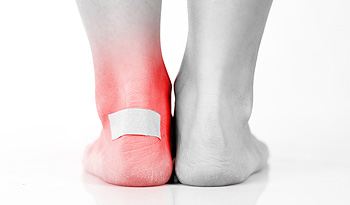 Blisters that develop on the feet can make it difficult to walk and complete daily activities. When the skin is irritated, the body’s natural healing response is to protect the damaged area by forming a small bubble over it that is filled with fluid. As new skin develops, the blister will gradually drain, and is no longer needed. Blisters generally develop from excess friction that is caused by wearing shoes or socks that do not fit correctly. Additional reasons why they can form can come from existing medical conditions such as psoriasis and eczema. Effective prevention techniques can include wearing comfortable shoes, checking the feet for signs of rubbing, and removing the shoes if discomfort is felt. If you would like additional information about how to treat and prevent blisters, please consult with a podiatrist.
Blisters that develop on the feet can make it difficult to walk and complete daily activities. When the skin is irritated, the body’s natural healing response is to protect the damaged area by forming a small bubble over it that is filled with fluid. As new skin develops, the blister will gradually drain, and is no longer needed. Blisters generally develop from excess friction that is caused by wearing shoes or socks that do not fit correctly. Additional reasons why they can form can come from existing medical conditions such as psoriasis and eczema. Effective prevention techniques can include wearing comfortable shoes, checking the feet for signs of rubbing, and removing the shoes if discomfort is felt. If you would like additional information about how to treat and prevent blisters, please consult with a podiatrist.
Blisters are prone to making everyday activities extremely uncomfortable. If your feet are hurting, contact Jeffrey Rosenblatt, DPM of New York. Our doctor can provide the care you need to keep you pain-free and on your feet.
Foot Blisters
Foot blisters develop as a result of constantly wearing tight or ill-fitting footwear. This happens due to the constant rubbing from the shoe, which can often lead to pain.
What Are Foot Blisters?
A foot blister is a small fluid-filled pocket that forms on the upper-most layer of the skin. Blisters are filled with clear fluid and can lead to blood drainage or pus if the area becomes infected.
How Do Blisters Form?
Blisters on the feet are often the result of constant friction of skin and material, usually by shoe rubbing. Walking in sandals, boots, or shoes that don’t fit properly for long periods of time can result in a blister. Having consistent foot moisture and humidity can easily lead to blister formation.
Prevention & Treatment
It is important to properly care for the affected area in order to prevent infection and ease the pain. Do not lance the blister and use a Band-Aid to provide pain relief. Also, be sure to keep your feet dry and wear proper fitting shoes. If you see blood or pus in a blister, seek assistance from a podiatrist.
If you have any questions, please feel free to contact our office located in Brooklyn, NY . We offer the newest diagnostic and treatment technologies for all your foot care needs.
